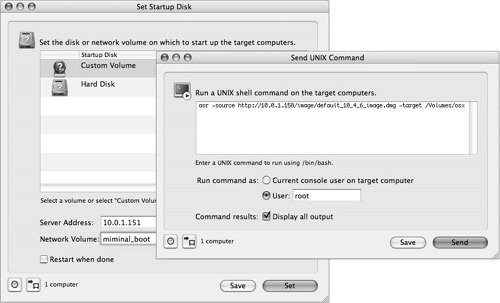Performing Remote Administration
| Apple Remote Desktop is an easy-to-use, powerful, open-standards-based desktop management application for all your networked Macintosh computers. You can remotely control and configure systems, install software, offer live online help to users, and assemble detailed software and hardware reports for an entire Mac network. The administration utility Remote Desktop lets you distribute software and related files to client computers. You can also distribute and automatically install packages and metapackages. ARD Admin lets you install software and software updates on one or more client computers without user interaction or interruption, whether or not a user is logged in. After installation, Remote Desktop erases the Installer files. If the computers need to be restarted, as they do following an operating-system update, restart them from Remote Desktop. For example, on your production computer, use Apple Software Update to download an iCal update to the model computer. If the update works as expected and introduces no compatibility issues, copy the install package to a computer running Remote Desktop to distribute to computers that need upgrading. Note that this approach conserves Internet bandwidth because only one copy of the package needs to be downloaded. Use this same method to distribute custom packages you created with PackageMaker.  Another example is to use Remote Desktop to set the startup volume of remote client systems to point to a Network Install image, and then remotely restart the clients to initiate installation. Before initiating installations that require computers to be restarted, send a text message to clients using Remote Desktop, notifying them of a pending installation and that you will log them off or lock their screen at a specific time to install an operating-system update. You can use Remote Desktop to set NetBoot images as the startup volumes of client systems and then restart the systems remotely. With just a few clicks you can reconfigure all the computers in a lab or cluster without having to manually restart and configure each computer individually. Remote Desktop can distribute and run UNIX shell scripts on client computers. For example, a script can mount an AFP server volume, from which it downloads a disk image to client computers. The script might also download an install package and then perform a command-line install. Remote UNIX commands also provide you with a powerful diagnostic and auditing tool, since you can issue any UNIX command on any number of machines and see the results in one collated list. Using Remote Desktop, you can distribute and install self-contained (drag-and-drop) applications by copying them to one or more client computers. To check whether an installation has been completed successfully, use Remote Desktop to observe the client computer remotely. Remote Desktop will be the focus of a lesson later in this book. |
EAN: 2147483647
Pages: 128